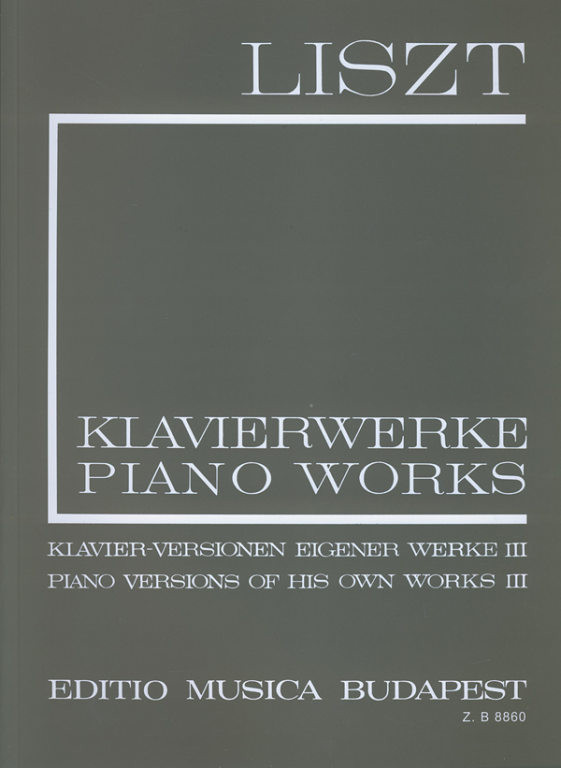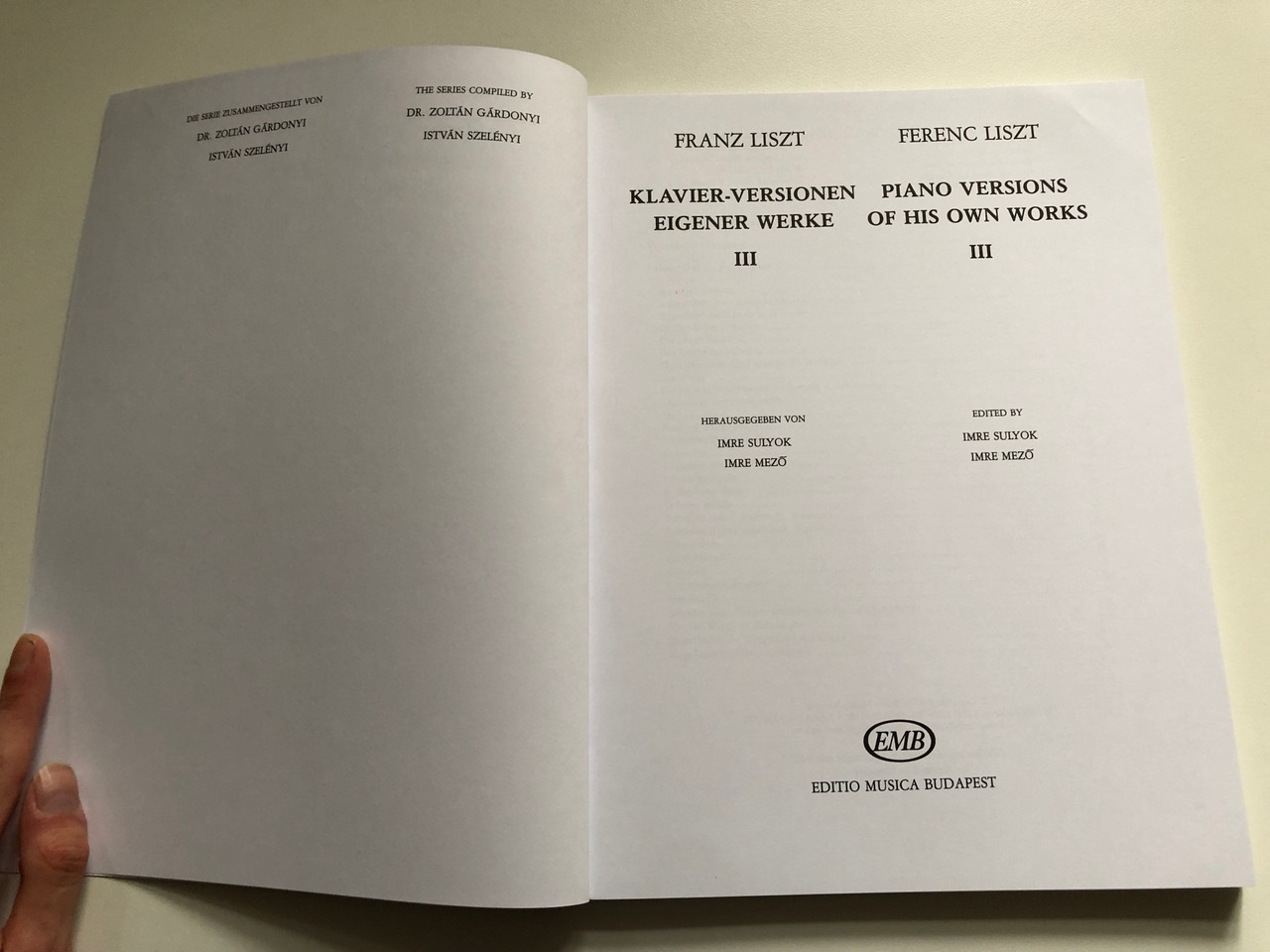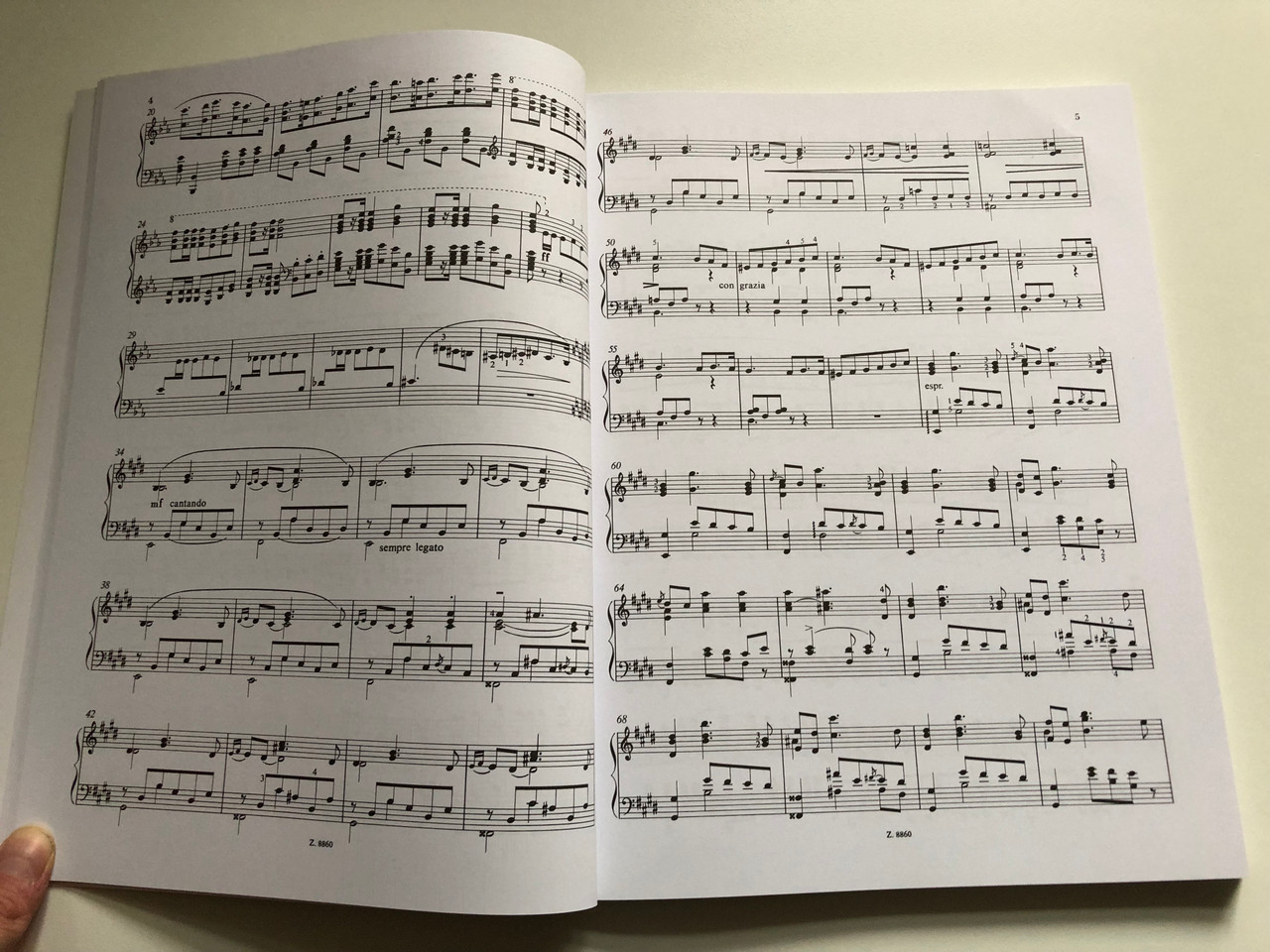Description
Liszt Ferenc: Piano Versions of His Own Works III / Edited by Sulyok Imre, Mező Imre / Editio Musica Budapest Zeneműkiadó / 1983 / Közreadta Sulyok Imre, Mező Imre
Setting: Piano
Series: New Liszt Edition I. 'B'
Genre: Complete Edition
Period: Romantic
Language: English, German
Length: 160 pages
Format: 23 x 30 cm
Weight: 0.585 kg
Published: 1983
Publisher: Editio Musica Budapest Zeneműkiadó
Item number: 8860
ISMN: 9790080088609 / 979-0080088609
Hangszer/letét: Zongora
Sorozat: Liszt Ferenc összes műveinek új kiadása I. (karton) 'B'
Műfaj: Összkiadás
Korszak: Romantikus
Nyelv: angol, német
Terjedelem: 160 oldal
Formátum: 23 x 30 cm
Súly: 0,585 kg
Első megjelenés: 1983
Kiadó: Editio Musica Budapest Zeneműkiadó
Katalógusszám: 8860
Volumes I/15-17 of the New Liszt Edition contain versions for piano of works by Liszt written for other instruments or for voices. Of the pieces in volume 17, many works appeared here in print for the first time: the Festpolonaise, the O Roma nobilis (whose melody can be traced back to a seventh- or eighth-century pilgrims' hymn), the San Francesco, the Cantico di San Francesco (in which the melody In dulci jubilo can be found) and In domum Domini ibimus. One interesting feature of A magyarok istene [God of the Hungarians] is that as well as the version for two hands, Liszt also made a piano transcription for left hand alone.
As far as possible, the pieces are given in chronological order. As customary, there are two versions of the publication: a blue clothbound edition and a grey softcover edition. The informative preface giving the most important information on the contents and technical details is identical in both versions, but only the former version includes an English description of the sources and a critical commentary. Both versions include facsimiles of pages from Liszt's original autograph manuscript.
Az Új Liszt-Összkiadás I/15-17. köteteiben Liszt saját, más hangszerekre vagy énekhangokra komponált műveinek zongoraváltozatai kaptak helyet. A 17. kötet darabjai közül számos mű itt jelent meg először nyomtatásban: a Festpolonaise, az O Roma nobilis (melyben a felhasznált dallam eredete egy 7-8. századi zarándokhimnuszra vezethető vissza), a San Francesco, a Cantico di San Francesco (melyben felfedezhető az In dulci jubilo dallama) és az In domum Domini ibimus. A magyarok istene c. darab érdekessége, hogy a kétkezes változat mellett Liszt csak bal kézre írt zongoraátiratot is készített belőle.
A darabokat lehetőség szerint időrendben közöljük. A kiadvány két változata az eddigiek szerint kék vászonkötésben és szürke kartonkötésben jelent meg. A művekről a legfontosabb tartalmi és technikai tudnivalókat ismertető angol és német nyelvű előszó mindkét változatban azonos, míg az angol nyelvű forrásleírásokat és kritikai megjegyzéseket csak az előbbi változat tartalmazza. A kötet elején mindkét változatban Liszt eredeti kéziratlapjainak hasonmásai láthatók.
Contents / Tartalomjegyzék
| 1. |
Festpolonaise *
R. (196) G. 528
|
||
| 2. |
Der blinde Sänger - Slepoj
R. 216 G. 546
|
||
| 3. |
Salve Polonia
R. 185 G. 51
|
||
| 4. |
Deux polonaises * (de l'oratorio St. Stanislas) Polonaise I *
R. 186 G. 519
|
||
| 5. |
Deux polonaises * (de l'oratorio St. Stanislas) Polonaise II *
R. 186 G. 519
|
||
| 6. |
O Roma nobilis *
R. (514) G ľ
|
||
| 7. |
San Francesco * (preludio per il Cantico del Sol, di San Francesco d'Assisi)
R. (392) G. 665
|
||
| 8. |
Cantico di San Francesco *
R. 191 G. 499
|
||
| 9. |
2. Mephisto-Walzer
R. 182 G. 515
|
||
| 10. |
A magyarok istene - Ungarns Gott
R. 214 G. 543
|
||
| 11. |
Von der Wiege bis zum Grabe - Du berceau jusqu' a la tombe
R. 179 G. 512
|
||
| 12. |
Die Zelle in Nonnenwerth (4. változat - 4th version - 4. Fassung)
R. 213 G. 534
|
||
| 13. |
Magyar király-dal - Ungarisches Königslied
R. 215 G. 544
|
||
| 14. |
In domum Domini ibimus - Zum Haus des Herrn ziehen wir *
R. 178 G. 505
|
||
| 15. |
Feuille d'album No. 2 (als 'Die Zelle in Nonnenwerth', 3. Fassung)
R. 64/2 G. 167
|
||
| 16. |
Ungarns Gott - A magyarok istene (Klavier-Transkription für die linke Hand - zongoraátirat bal kézre)
R. 214 G. ľ
|






























































